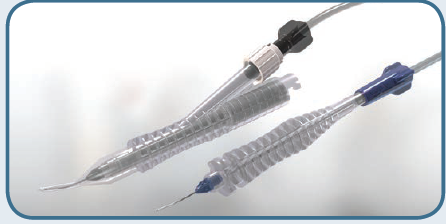
Cataract surgery is one of the most successful surgeries in medicine. We consistently achieve excellent outcomes safely and efficiently, so the bar is already high. Consequently, any changes we consider incorporating into our surgeries, whether in instrumentation or technique, need to produce incremental improvement that will help us raise that high bar even higher. The INTREPID Transformer I/A Handpiece (Alcon) has done that for me.
Flexibility in the OR
One of the challenges we all face is not knowing how an eye will behave until we start a case. Those of us who are primarily coaxial surgeons know that situations arise where a bimanual approach would be preferable, but often we do not have the tools readily available to switch. When faced with persistent subincisional cortex while in coaxial mode, for example, we may have to torque the incision or the eye to gain access and remove the cortex. Although we eventually find a way to complete the task, our maneuvers are not so gentle on the eye or easy on the surgeon.
When using the Transformer I/A Handpiece, I can switch from coaxial to bimanual mode within seconds without coming out of the eye, changing tubing and settings, disrupting the surgery, or adding time to the procedure. I can easily remove subincisional cortex without putting additional stress on the primary incision or changing the contour of the eye. The Transformer gives me the flexibility to be the surgeon I am most comfortable being, as each case warrants.
One Handpiece, Multiple Benefits
The Transformer looks like a typical coaxial I/A handpiece (Figure 1A), but with just a twist and a pull, it becomes a bimanual instrument, separating into two individual components: an irrigation sleeve, which remains in the primary incision, and a polymer-tipped aspiration port, which is inserted into a secondary incision (Figure 1B). In coaxial mode, the Transformer enables us to perform one-handed cortex removal. In bimanual mode, the sleeved portion of the handpiece maintains chamber stability while the transformed aspiration port is free to enter a side incision.

Figure 1. John Berdahl, MD, holds the INTREPID Transformer I/A Handpiece in coaxial mode (A) and bimanual mode (B).
In my opinion, the Transformer I/A Handpiece in bimanual mode is at its very best in cases with loose zonules and sticky cortex. Pseudoexfoliation cataract is a great example of where this instrument really shines, because I can operate at the ideal angle to remove cortex while exerting the least amount of tension on the zonules.
Another benefit of the Transformer in bimanual mode is that I can use the polymer-tipped aspirating port to polish the underside of the anterior capsule. I believe polishing residual lens epithelial cells from the underside of the anterior capsule helps prevent capsular phimosis and minimizes postsurgical inflammation. With the Transformer, I can accomplish this without trading out instruments in the eye. This is one of those incremental advantages that I welcome.
I have also found that in bimanual mode, the incision is not disrupted. When I am implanting IOLs with the use of the ORA SYSTEM (Alcon), I obtain more predictable readings from the aberrometer and am more likely to get closer to my refraction goals. I also like to use bimanual technique to make micro adjustments to a toric IOL while aligning it.
Capsular-friendly Polymer Tip
I switched to the disposable, single-use polymer tip for all of my coaxial surgeries years ago, and it has been great. Not only is it forgiving if you engage the posterior capsule, but it also allows you to polish the posterior capsule quite aggressively with little risk of rupturing it. The same smooth polymer tip that we have used for years for coaxial irrigation and aspiration is also part of the Transformer Handpiece.
Performing Double Duty
The INTREPID Transformer I/A Handpiece functions as a good coaxial irrigation and aspiration tip, but the magic behind it is that it also functions as an excellent bimanual irrigator and aspirator (Figure). With just a twist and a pull, you get the performance benefits of both modes during the same procedure.

Figure. The INTREPID Transformer I/A Handpiece functions as a coaxial irrigation and aspiration tip and a bimanual irrigator and aspirator.
• Coaxial Performance
– All of the advantages of the Alcon INTREPID polymer technology
– Smooth, capsular-friendly tip
– Enhanced irrigation flow
– Accessibility to cortical material in the majority of clock hours
• Bimanual Performance
– Greater access to subincisional cortex
– Increased capsular polishing flexibility via the polymer-tipped bimanual aspirating port
– Flexibility to switch the aspirating handpiece to the other side to access any remaining cortex.
Advances in Efficiency
If I were to describe in one word the overarching advantage to using the Transformer I/A Handpiece, it would be efficiency, which is particularly important for those of us who operate in ambulatory surgery centers.
First, being able to switch back and forth from coaxial to bimanual mode with one instrument as I see fit during a procedure is very efficient.
Second, if I am spending time trying to remove stubborn cortex either subincisionally or from an area where the angle of approach is not ideal, the Transformer I/A Handpiece in bimanual mode will help me get a proper angle. Being able to make the transition quickly and easily facilitates a more physiologic and efficient surgery with the potential for better outcomes.
Third, the Transformer allows me to polish the posterior side of the anterior capsule in 360° without needing to use a different instrument to accomplish that.
An Intuitive Instrument
It is quite easy to incorporate the Transformer I/A Handpiece into your OR to determine if it will bring value to your surgery day. There is really no downside.
The learning curve is minimal because the instrument is so intuitive. The hand position is not much different from what you usually use with your second instrument and your main incision for disassembly of the cataract.
My only suggestion is for surgeons whose primary and secondary incisions are closer together. I recommend that you make your incisions around 90° apart, because the foremost advantage of bimanual irrigation and aspiration is getting the subincisional cortex, and if your primary and secondary incisions are too close together, your angle of approach will not be ideal. As an example, my sideport incision is 1 mm, and I place it about 100° to the left of my primary incision.
Conclusion
The Transformer I/A Handpiece is helping to raise the already high bar of cataract surgery by facilitating some of the incremental advancements that will make a positive difference in outcomes. Gentler manipulations of the eye, faster and more thorough removal of residual lens epithelial cells, more precise toric IOL alignment, and less postoperative inflammation are some of the benefits, in my experience, of this instrument that will contribute to better, more predictable outcomes.
